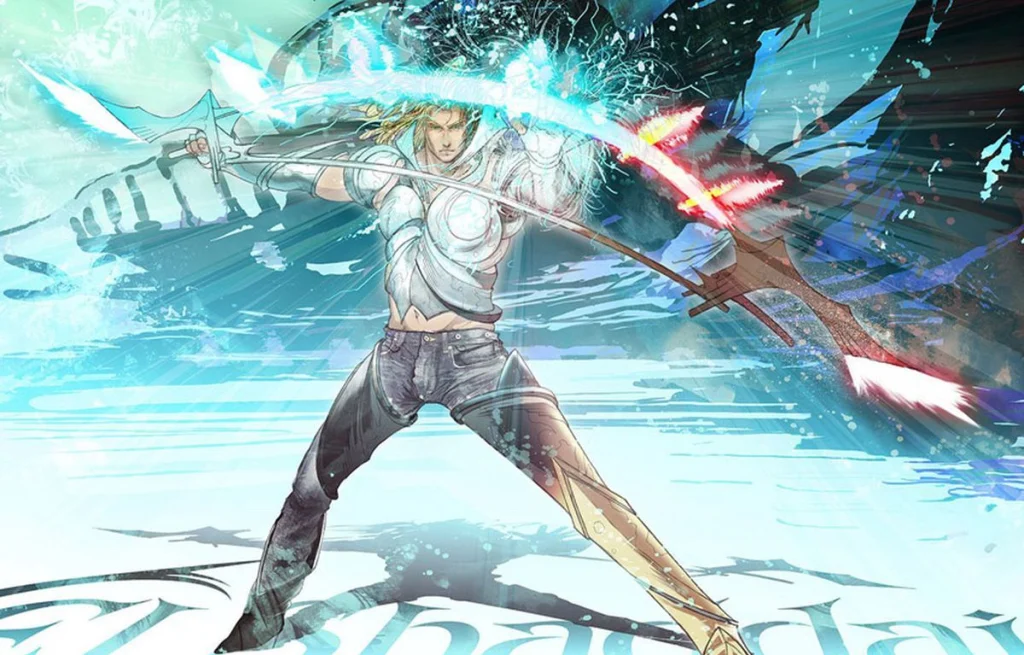It tells a story taken from the Bible from apocryphal texts (non-canon): in the texts, Enoch is a human who ascends to heaven, is named guardian of the archangels, and becomes Metatron, an angel who transmits the divine word, if I roughly summarize what I read; but it’s much more complicated than that and there are lots of texts that tell different things or contradict each other. In the game, we are sent on a mission to capture or eliminate fallen archangels, guided by “Lucifel” who is represented by a guy in a suit who is constantly on the phone with God to inform him of our progress, and who knows how to stop or rewind time but who cannot physically intervene.

We are quickly struck by the extremely worked aesthetic of the title, which goes from an idyllic nature filled with psychedelic watercolor effects that change before our eyes, to an SF dystopia with geometric settings, passing through lots of other original looks: the atmosphere is excellent and unique, and it is supported by perfect music and an empty interface, without a life bar or any indicator.
El Shaddai’s level design is much more classic: the levels are completely linear, in the form of corridors punctuated by arenas, then a boss; from time to time we will activate a switch or look for access to hell, which is an optional challenge. We spend a lot of time moving forward in empty corridors, without doing anything except admiring the crazy landscapes; there are also platform passages, but unfortunately, this is probably the least successful aspect of the game: the simplistic physics are not really up to par, and since the camera is not controlled, some passages make you want to scream in frustration. Fortunately, falling is not penalizing, because you come back just a few seconds earlier.
The fights are very simple: with 4 buttons used (jump, attack, block, special) that can be combined (jump and block make a dodge, for example), as well as some subtleties, like a “perfect guard” that opens the enemy to a counterattack. There are no RPG-type mechanics, XP, or any skill tree; the only variety is that you can steal 3 types of weapons from the enemies, each with different attacks (fast, powerful, or ranged) but also a special ability: float for a few moments, dash, or a big strike that can break certain elements of the scenery. The weapons work on a rock/paper/scissors system, but unfortunately, they are not very well balanced, and the “veil” is much more powerful than the others.
The difficulty of El Shaddai is hard to pin down: with fights that don’t lock on enemies, I often hit the wrong way and I never really managed to “get into the rhythm” of the game: even on easy I regularly lost, including during “normal” fights; fortunately, there is a mechanic that allows you to simply mash the buttons to immediately resurrect and continue the fight, very practical in the final fight. Without a progression mechanic, the difficulty curve is relatively flat: we encounter slight variations of the same handful of enemies throughout the game, who have the same 3 weapons, they are just more numerous and hit slightly harder or faster at the end, but it is not obvious.
After less than 6h30 of play (without looking for any bonuses), we unlock an art book, but also an oddity: a small novel of about a hundred pages, which tells the last part of the game, followed by what happens after. It’s very strange because it tells so many events that I see enough to make a second or even a third game; it’s a shame that this remaster didn’t illustrate these scenes, even if it meant just making static drawings narrated by a voiceover: as it is, it just screams “we didn’t have enough budget for the final cutscene”… Reading this book is also mandatory to have a real conclusion to the story: it tells the years of fighting that follows the end of the game, until a finale that gives coherence to the rest of the game.
Technically, it’s a bit shaky: this Switch version has a resolution mode and a performance mode, but the first has a regularly degraded framerate, and the second sometimes allows you to count the pixels with the naked eye. The game is also full of small bugs and finalization issues: putting the console on standby during a cutscene cuts it off or speeds it up when turning it back on, there are lots of small animation bugs, some collision problems with the character passing through walls or the floor, and the lipsync in English is completely broken, with moments where the characters’ lips move without any sound coming out. Too bad because the English voices are of good quality, but you can put the Japanese voices back on at any time (and the subtitles in French).
